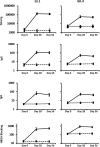Serological Correlates of Protection against a GII.4 Norovirus
- PMID: 26041041
- PMCID: PMC4519714
- DOI: 10.1128/CVI.00196-15
Serological Correlates of Protection against a GII.4 Norovirus
Abstract
Noroviruses are the leading cause of acute gastroenteritis worldwide, and norovirus vaccine prevention strategies are under evaluation. The immunogenicity of two doses of bivalent genogroup 1 genotype 1 (GI.1)/GII.4 (50 μg of virus-like particles [VLPs] of each strain adjuvanted with aluminum hydroxide and 3-O-desacyl-4'monophosphoryl lipid A [MPL]) norovirus vaccine administered to healthy adults in a phase 1/2 double-blind placebo-controlled trial was determined using virus-specific serum total antibody enzyme-linked immunosorbent assay (ELISA), IgG, IgA, and histoblood group antigen (HBGA)-blocking assays. Trial participants subsequently received an oral live virus challenge with a GII.4 strain, and the vaccine efficacy results were reported previously (D. I. Bernstein et al., J Infect Dis 211:870-878, 2014, doi:10.1093/infdis/jiu497). This report assesses the impact of prechallenge serum antibody levels on infection and illness outcomes. Serum antibody responses were observed in vaccine recipients by all antibody assays, with first-dose seroresponse frequencies ranging from 88 to 100% for the GI.1 antigen and from 69 to 84% for the GII.4 antigen. There was little increase in antibody levels after the second vaccine dose. Among the subjects receiving the placebo, higher prechallenge serum anti-GII.4 HBGA-blocking and IgA antibody levels, but not IgG or total antibody levels, were associated with a lower frequency of virus infection and associated illness. Notably, some placebo subjects without measurable serum antibody levels prechallenge did not become infected after norovirus challenge. In vaccinees, anti-GII.4 HBGA-blocking antibody levels of >1:500 were associated with a lower frequency of moderate-to-severe vomiting or diarrheal illness. In this study, prechallenge serum HBGA antibody titers correlated with protection in subjects receiving the placebo; however, other factors may impact the likelihood of infection and illness after virus exposure. (This study is registered at ClinicalTrials.gov under registration number NCT1609257.).
Trial registration: ClinicalTrials.gov NCT01609257.
Copyright © 2015, American Society for Microbiology. All Rights Reserved.
Figures

References
-
- Payne DC, Vinjé J, Szilagyi PG, Edwards KM, Staat MA, Weinberg GA, Hall CB, Chappell J, Bernstein DI, Curns AT, Wikswo M, Shirley SH, Hall AJ, Lopman B, Parashar UD. 2013. Norovirus and medically attended gastroenteritis in U.S. children. N Engl J Med 368:1121–1130. doi:10.1056/NEJMsa1206589. - DOI - PMC - PubMed
-
- Green KY. 2013. Caliciviridae: The noroviruses, p 582–608. In Knipe DM, Howley PM (ed), Fields virology. Lippincott Williams & Wilkins, Philadelphia, PA.
Publication types
MeSH terms
Substances
Associated data
Grants and funding
LinkOut - more resources
Full Text Sources
Other Literature Sources
Medical
Research Materials
Miscellaneous

